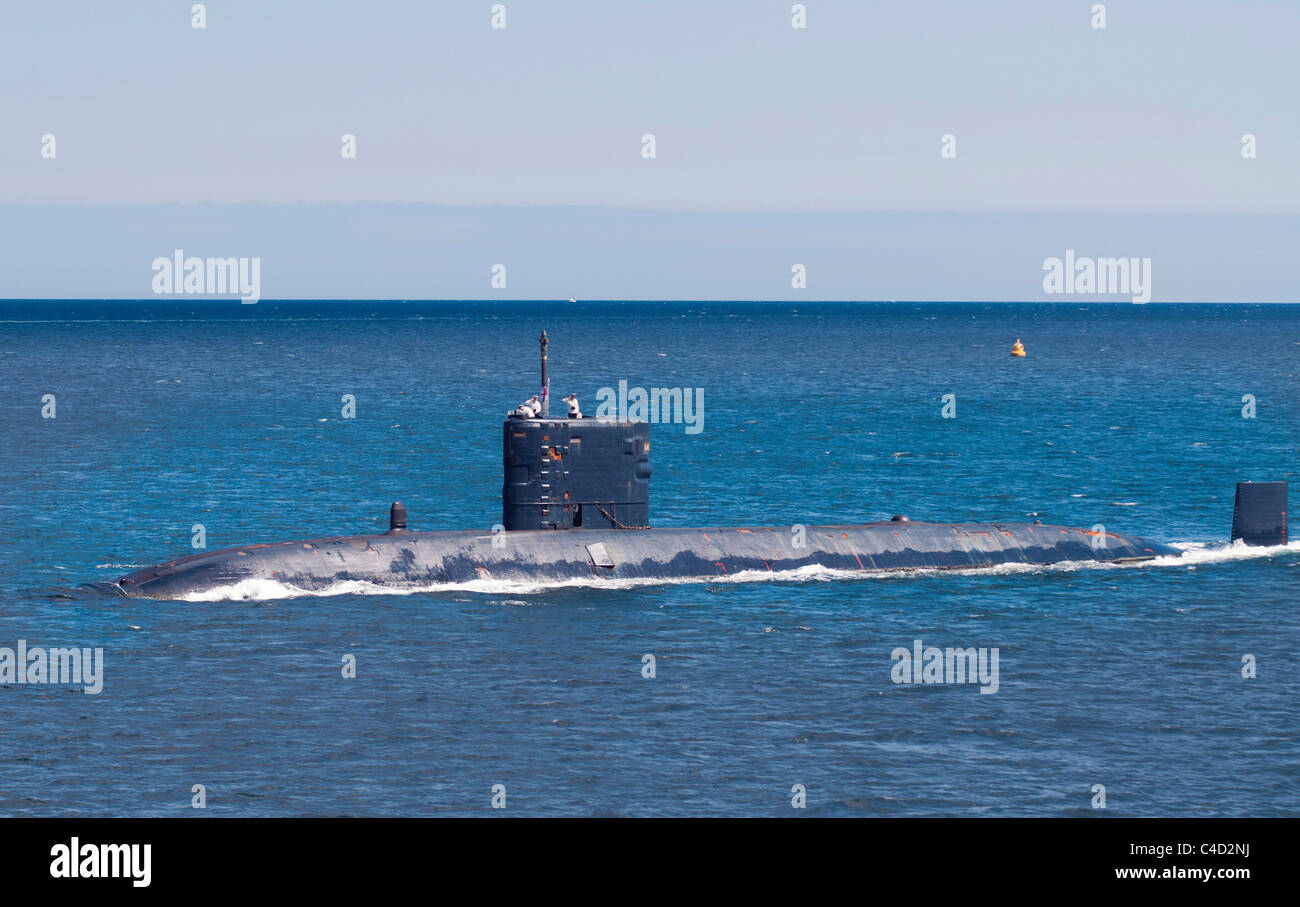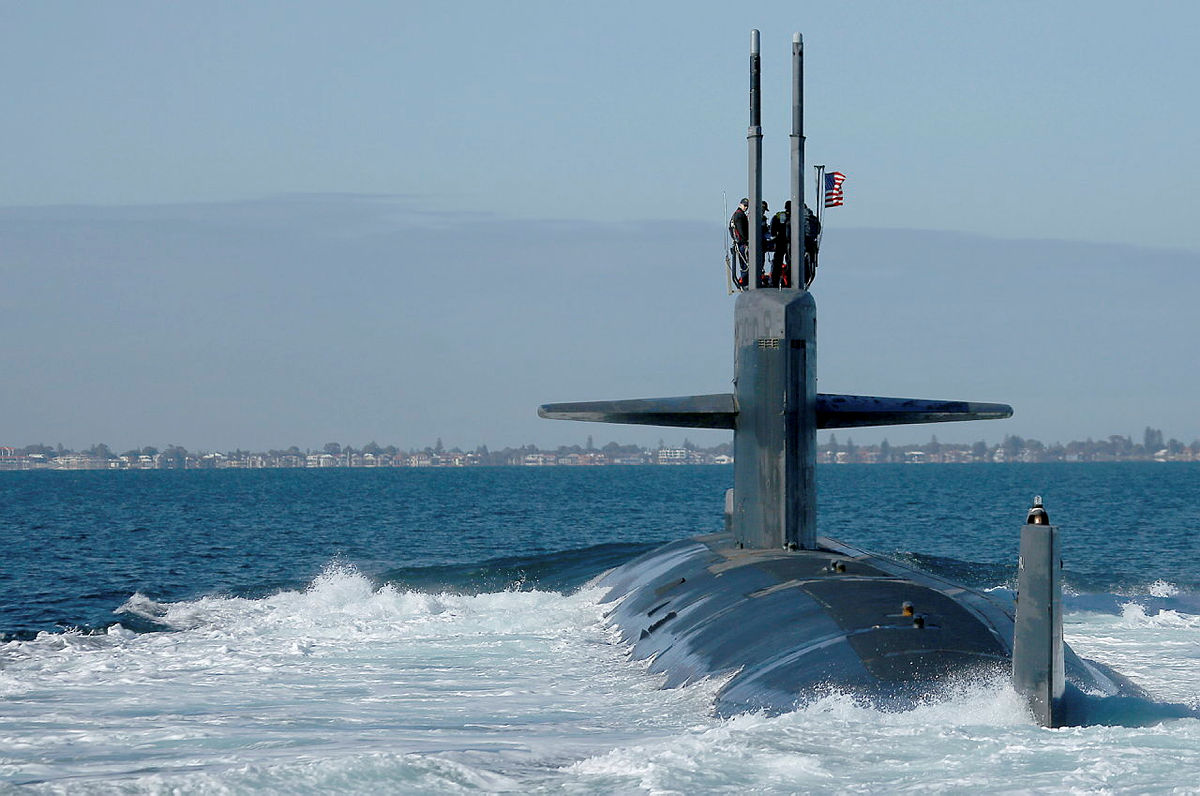Trafalgar Class Submarine - The Royal Navy is left with its only operational nuclear attack submarine following the decommissioning of HMS Talent and Trenchant at Devonport Naval Base on 20 May.
The once seven-boat Trafalgar class, which has been in service since the 1980s, will be replaced by the new Astute class. Four smarters have been commissioned, with HMS Anson, soon to join number five, successfully completing diving trials.
Trafalgar Class Submarine
With the retirement of Talent and Trenchant, the only Trafalgar unit still in service remains the youngest submarine, HMS Triumph, commissioned in 1991.
British Nuclear Submarine Involved In Near Miss With Car Ferry In Irish Sea
The crews of the two retired boats were paraded for the last time in Plymouth in front of HRH The Princess Royal - Patron of HMS Talent, as well as dignitaries and past commanders.
Trenchant's operational career ended last year and Talent completed its last patrol earlier this spring. Both boats served for 32 years. As hunter-killer submarines, their mission was to protect the nation's strategic nuclear deterrent, first Polaris, now Trident, and to detect, track and classify targets.
The boats are capable of receiving intelligence, sneaking troops ashore or targeting enemy submarines and ships with Spearfish torpedoes and Tomahawk cruise missiles.
"The Trafalgar class has earned a world-class reputation and has steadfastly defended the UK's interests across the oceans. Great submarines have now taken over the baton and continue to protect the UK from threats with deep professional submarine crews," said Commodore Submarine Service Commodore James Perks.
Faslane Fleet Grows With Arrival Of Trafalgar Class Submarine
"While we are grateful for the service provided by HMS Talent and HMS Trenchant, we can also look with great excitement to the future. We have the world's best attack submarines in the Astute class, and advances in submarine training mean we have the best men and women who swim, fight and protect our nation far into the future."
After Talangen's initial training period, in 1991 she sailed directly to the Mediterranean and played an active role in the first Persian Gulf War, the boat's efforts were praised by the American officer in command of the submarine group, Admiral Ryan, who personally congratulated the crew.
"It was an emotional day for many shipping companies. I know very well the common bond of all who have worked on board the Talangen during their time in the fleet. The many visits to ports, exercises, memories and events are all interspersed with the rich and inspiring history of the submarine, which has demonstrated constant vigilance at the front line of defense for Britain and indeed the world.The dedication, determination and commitment shown by the ship's company over the years is commendable and the talent will be sorely missed as his Ensign has been demoted for the final time ."

This website uses cookies to improve your experience. We think it's good for you, but you can opt out if you want. Cookie settings ACCEPT
Trafalgar Class Submarine
This website uses cookies to improve your experience when browsing the website. Among these cookies, cookies categorized as necessary are stored in the browser because they are necessary for the operation of the website's main functions. We also use third-party cookies to help us analyze and understand how you use this website. These cookies are stored in your browser only with your consent. You also have the option to refuse these cookies. However, opting out of some of these cookies may affect your browsing experience.
Necessary cookies are necessary for the website to function properly. This category only includes cookies that provide basic functionality and security features on the website. These cookies do not store any personal information.
All cookies that may not be necessary for the website to function and that are specifically used to collect users' personal data through analytics, advertisements, other embedded content are called non-essential cookies. It is mandatory to obtain the user's consent before activating these cookies on your website. The Trafalgar class is a class of nuclear-powered fleet submarines (SSN) in service with the Royal Navy and is the successor to the Swiftsure class. Like most of the Royal Navy's nuclear submarines, all the ships are built at the Barrow-in-Furness shipyard in Cumbria. With only one boat active and in service (as of 2022) and six originally in service that have been retired, the class forms part of the Royal Navy's nuclear "hunter-killer" submarine force. The Trafalgar class is gradually being replaced by the larger and more capable Astute class, five of which are now in service.
The name Trafalgar refers to the Battle of Trafalgar in 1805 between the Royal Navy and the combined fleets of France and Spain.
Trafalgar Class Ssn
The Trafalgar class was designed in the early 1970s as a refinement of the earlier Swiftsure class during the Cold War. Including HMS Dreadnought, the Trafalgar class is the fifth class of nuclear powered submarines in service with the Royal Navy. First class HMS Trafalgar was commissioned on 7 April 1977 and completed in 1983. The last, HMS Triumph, was commissioned on 3 January 1986 and completed in 1991. All seven boats in the class were built and completed by Vickers Shipbuilding. and engineer at Barrow-in-Furness Shipyard.
Jane's Fighting Ships wrote in 1982: "The estimated cost of the fourth submarine was £175 million, including equipment and weapons systems." In 1986 Jane's Fighting Ships reported that the average cost of this class was £200 million at 1984-85 prices.
In 1987, Canada's White Paper on Defce proposed the purchase of 10-12 Rubis- or Trafalgar-class submarines through technology transfer.
In April 1989, the purchase was canceled due to financial difficulties. In 1998, the Canadian government signed an agreement to purchase four diesel-electric submarines of the Royal Navy's Upholder class.
Great Britain Trafalgar Class Nuclear Attack Submarine 1:350
Submarines of the class are in a wide range of service, especially during the conflicts in Afghanistan, Iraq and Libya, firing "Tomahawk" land-based cruise missiles at targets. Three Trafalgar-class boats took part in such operations. In 2001, Trafalgar became the first Royal Navy submarine to fire Tomahawk cruise missiles at Afghanistan, taking part in Operation Veritas against al-Qaeda and Taliban forces following the 9/11 attacks in the United States.
In April 2003, HMS Turbult returned home in a Jolly Roger after firing thirty Tomahawk cruise missiles during the invasion of Iraq.
In 2011, as part of the military intervention in Libya, HMS Triumph fired her Tomahawk cruise missiles three times; only on March 19
Triumph returned to Devonport on 3 April 2011 with the Jolly Roger decorated with six small Tomahawk axes to display the missiles fired by the submarine during the operation.
Uk To Develop New Class Of Nuclear Submarine
In 1993, the Triumph sailed to Australia, covering a distance of 41,000 miles (66,000 km) underwater and without any forward support. As of 2011, it remains the longest single deployment of any British nuclear-powered submarine.
In 1998, Trchant experienced a steam leak, forcing the crew to shut down the nuclear reactor. In 2000, Tireless was found to have a leak in the primary cooling circuit of the PWR1 reactor, forcing it to continue to Gibraltar on diesel power.
It was determined that the failure was due to thermal fatigue cracking, which required urgent inspection and, if necessary, modification of the other Trafalgar-class boats and some of the remaining Swiftsure-class boats.

In 2013, the nuclear safety regulator Defce announced that the reactor systems had technical problems due to aging that required effective management. Tireless, for example, leaked a small amount of radioactive coolant over eight days in February 2013.
Hms Talent Retired. Royal Navy Down To Just 5 Attack Submarines
Type 23 frigate HMS St Albans Turbult with a Merlin helicopter during anti-submarine training in the Gulf of Oman, 2011.
As a refinement of the earlier Swiftsure class, the design of the Trafalgar class shares some similarities, including its internal layout and the Rolls-Royce PWR1 Core 3. However, some improvements over the Swiftsure class include its reduced acoustic signature, with the hull covered with anechoic plates designed to absorb rather than reflect sound, making boats quieter and harder to detect with active sonar. A pump engine system is also used from the 2nd boat onwards instead of a conventional propeller.
Like all Royal Navy submarines, the Trafalgar class have fins and retractable hydroplanes to allow them to surface through thick ice.
Four boats in the class Torbay, Trchant, Talt and Triumph are equipped with the Sonar 2076 system. Since 2014, the last four boats in the class have undergone an upgrade of the communication package.
Project To Dismantle Ex Royal Navy Nuclear Submarines Inches Forward
The Trafalgar class is equipped with five 21-inch (533 mm) torpedo tubes, with up to 30 weapon combinations:
Tomahawk missiles can hit targets within a few meters, up to 1,000 miles (1,600 km).
Apparently submarines use the same steering column that was used on Wellington bombers in World War II.

Originally, the last five Trafalgar-class submarines were to be replaced by the Future Fleet Submarine programme, but this was effectively canceled in 2001.
The Ship Model Forum • View Topic
Balao class submarine model, ohio class submarine model, virginia class submarine model, virginia class submarine, airfix trafalgar class submarine, trafalgar class, columbia class submarine, ohio class submarine, trafalgar submarine, trafalgar law submarine, gato class submarine model, trafalgar class submarine model
0 Comments